Apple Introduces M2 Processor: 8-Core CPU, 10-Core GPU, up to 18% More Performance (Updated)
Apple announced its Apple Silicon M2 processors today, saying that the new second-gen chips offer up to 18% more performance in unspecified multi-threaded CPU-focused tasks, while the revamped 10-core GPU offers up to 35% more performance in unspecified graphics workloads. Apple also bumped maximum memory capacity up to 24GB of LPDDR5, and the next-gen 16-core neural engine is 43% faster than its predecessor and can process up to 15.8 trillion operations per second.
The new M2 chips come fabbed on a second-generation 5nm process, presumably TSMCs N5P, and have 20 billion transistors. The first M2 processors will debut in the MacBook Air and the MacBook Pro, which will be available next month.
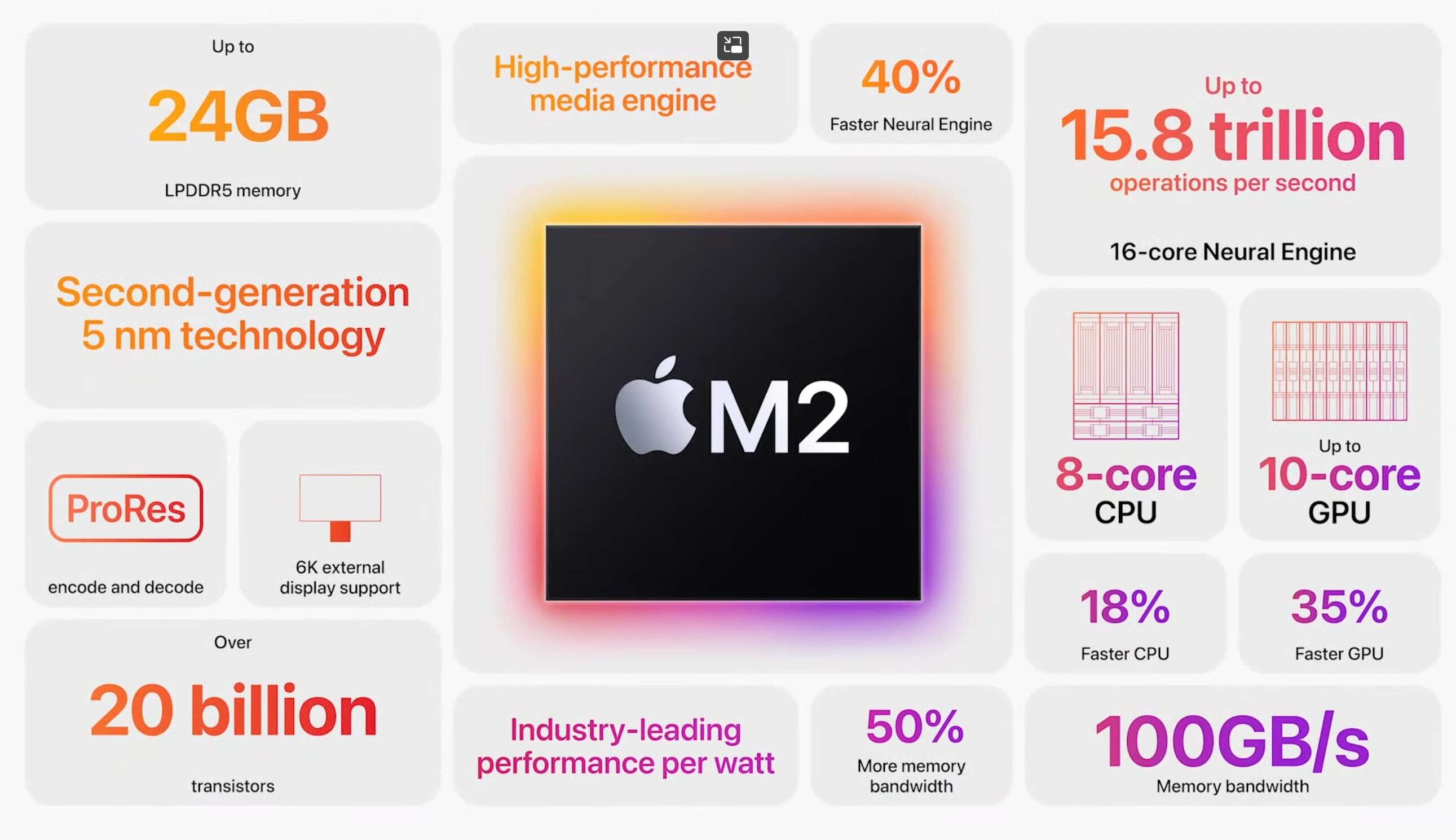
The Arm-powered Apple Silicon chips have reinvigorated the company's PC products with the now well-known M1, M1 Pro, M1 Max, and M1 Ultra chips enabling the company to cut ties with Intel processors and move to more advanced chip fabrication technology and the Arm microarchitecture. That trend continues as Apple moves forward to the second-gen 5nm process and a more performant chip architecture that sees advancements in all of the key architectural units.

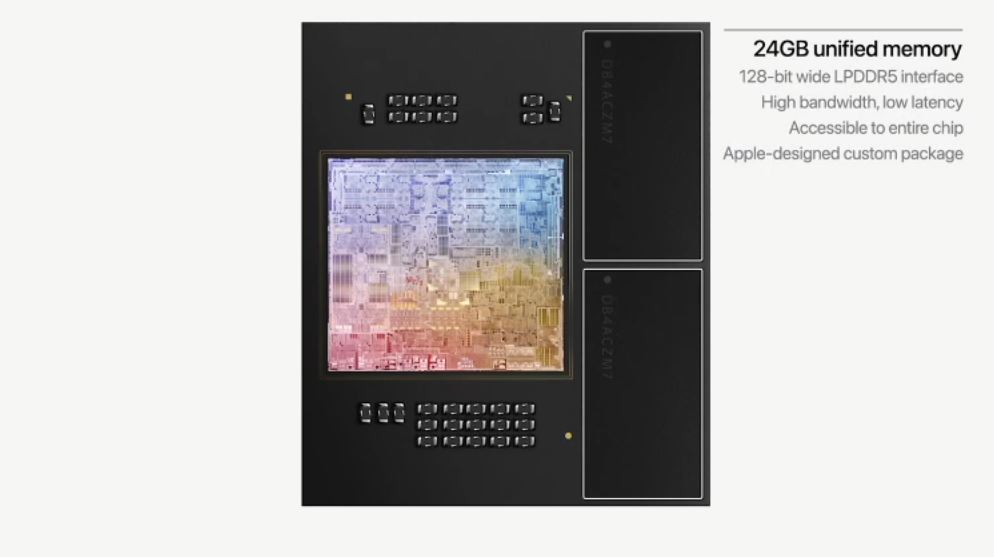
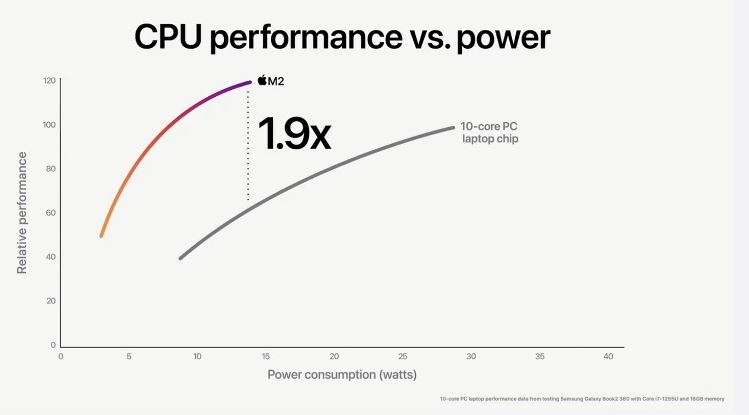
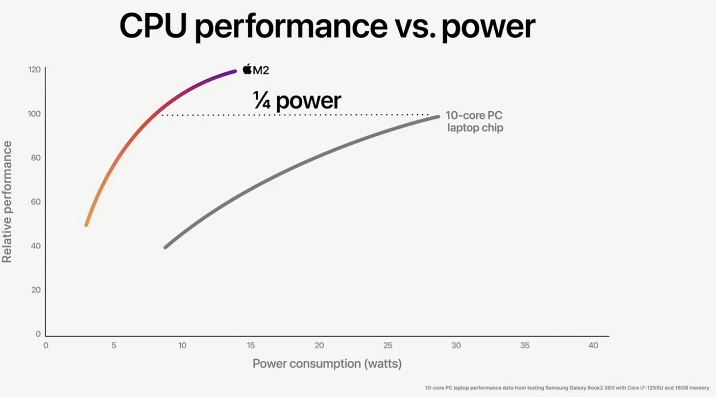
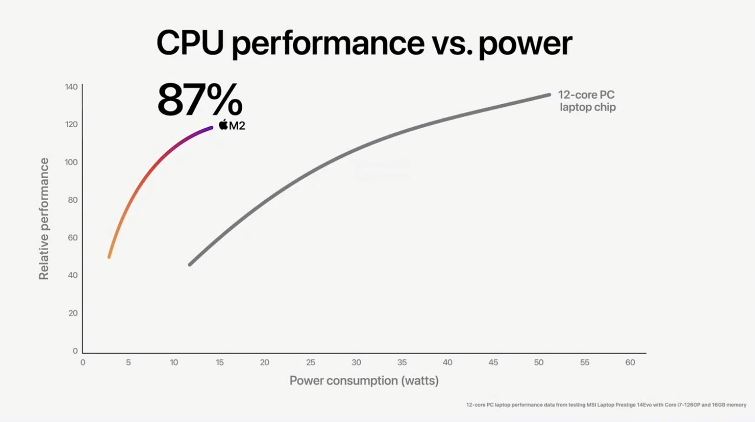
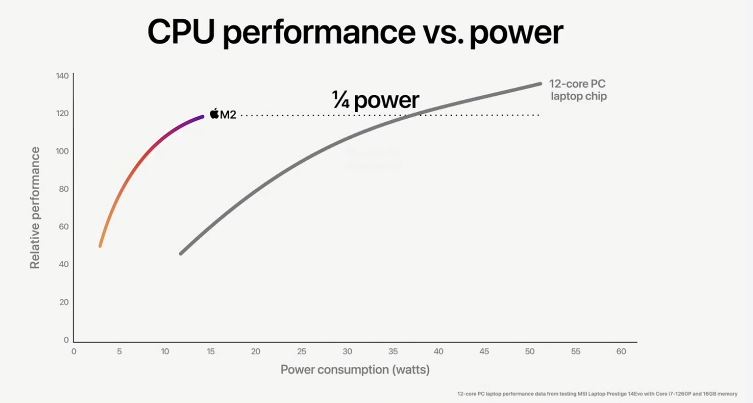
| Row 0 - Cell 0 | Apple Silicon M2 CPU | Apple Silicon M1 CPU |
| Performance Cores | 4 | 4 |
| Efficiency Cores | 4 | 4 |
| Transistors | 20 Billion | 16 Billion |
| Core Architecture (P- / E-Core) | Avalanche / Blizzard (not confirmed) | Firestorm / Icestorm |
| Memory | 24 GB of LPDDR5 (100 GB/s) | 16GB of LPDDR4X-4266 (68 GB/s) |
| Share L2 Cache (P- / E-Core) | 16 MB / 4 MB | 12MB / 4 MB |
| Instruction Cache (P- / E-Core) | 192 / 192 KB | 192 / 192 KB |
| Data Cache (P- / E-Core) | 128 / 64 KB | 128 / 64 KB |
| Neural Engine | 15.8 TOPS | 11 TOPS |
The M2 processors come with up to eight CPU cores, the same as their predecessors, with four high-performance and four efficiency cores. The M2 chip appears to be based on the A15 Avalanche+Blizzard architecture with ARMv8.5-A, and not Armv9. The high-performance cores have a beefed-up cache, with 16MB of shared L2 cache compared to M1's 12MB L2. The four efficiency cores have an unchanged cache capacity hierarchy compared to the M1 processors.
As with all performance claims from a vendor, you should take these with a grain of salt. As you can see in the above album, Apple claims that the combination of these CPU cores offers up to 18% more performance than the M1 in an unspecified multi-threaded CPU workload — this means that the 18% performance improvement is not indicative of increased instruction per cycle (IPC) throughput.
This unknown threaded benchmark also doesn't tell us which group of cores, be they efficiency or performance, contribute the most to the increased performance. The performance cores (P-cores) handle latency-sensitive work for high-performance applications, while four efficiency cores (E-cores) step in for background and threaded workloads. It is common knowledge that the A15 architecture's E-cores deliver a larger performance increase than the P-cores, so we might see muted gains with the M2 in lightly-threaded work.
The company also claims the M2 chips offer 1.9X the performance of a 10-core Intel Core i7-1255U processor paired with 16GB of memory, but with both chips constrained to the same power limit — not at peak performance. Apple also claims the M2 offers the same peak performance as the 10-core chip but at 1/4th the power. Moving up to a 12-core Intel Core i7-1260P, Apple claims it delivers 87% of the peak performance while using 1/4th of the power.

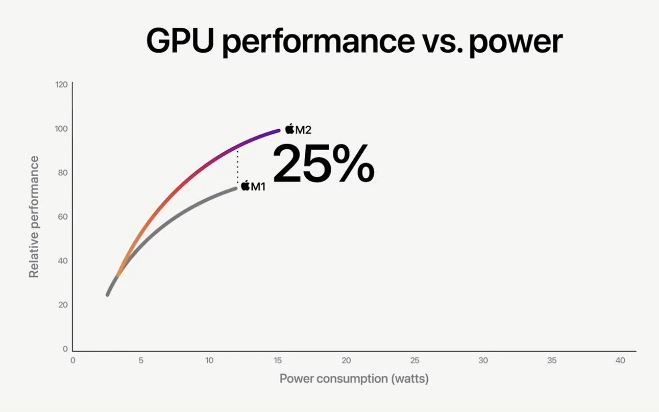
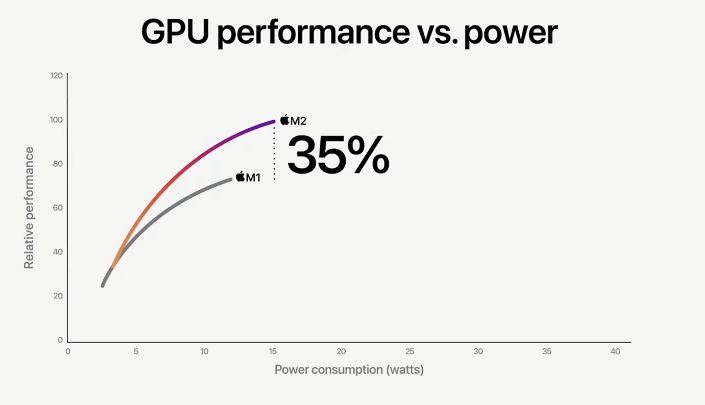
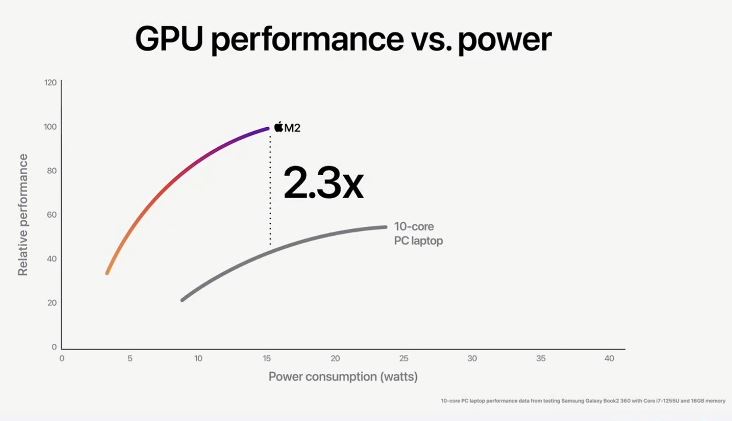
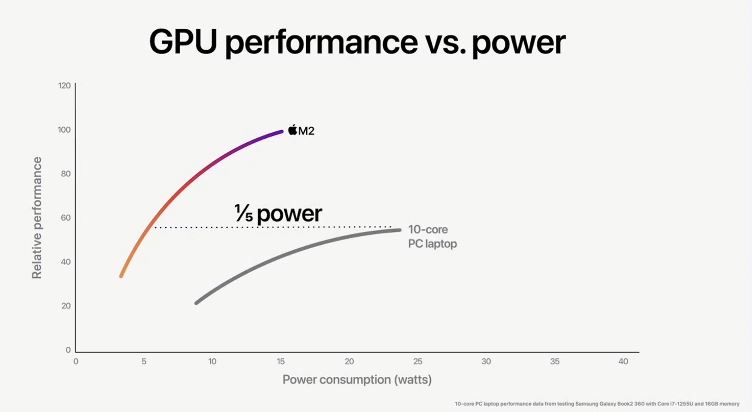
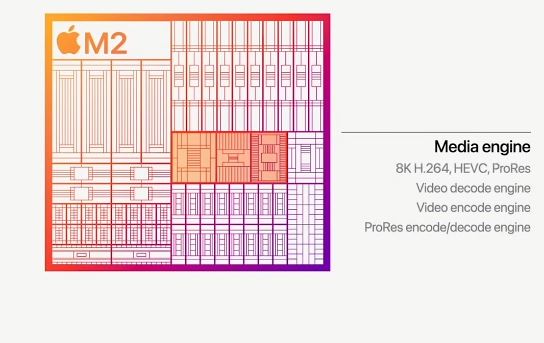
| Row 0 - Cell 0 | Apple Silicon M2 GPU | Apple Silicon M1 GPU |
| Cores | 10 Cores | 8 Cores |
| Teraflops | 3.6 | 2.6 |
| Gigatexels/Second | 111 | 82 |
| Gigapixels/Second | 55 | 41 |
The GPU has also seen an overhaul, increasing from the eight cores present on the M1 chips to ten cores, which Apple says contributes to a 35% gain in GPU performance, again with an unspecified workload. The M2's GPU is spec'd at 3.6 teraflops, a sizeable 38% increase over the 2.6 teraflops from the M1's GPU.
The media engine supports up to 8K H.264, HEVC, has ProRes encode/decode, and features 'increased bandwidth' that allows it to play back multiple 4K and 8K streams. As before, the chip only supports two displays, with one external up to a 6K resolution. As Apple has done in the past, we expect the company to ship different M2 models with varying numbers of GPU cores.
Apple claims the M2's GPU delivers up to 25% more performance at the same power as the M1 and up to 35% more performance at peak power. However, in a rather meaningless comparison, Apple compared its GPU to a Core i7's integrated GPU that isn't meant for any serious work. Apple claims a 2.3X advantage over Intel's iGPU at the same power, and the same peak performance at 1/5th the power.
Apple feeds both the CPU and the GPU with up to 100 GB/s of memory bandwidth via up to 24GB of on-package LPDDR5 memory, a 50% increase in bandwidth over the prior-gen M1 chips. That comes courtesy of the step up to LPDDR5 over the M1's LPDDR4X. The M2 also has a 50% increase in memory capacity (the M1 topped out at 16GB). The LPDDR5 memory communicates across a 128-bit wide bus.
Specialized silicon for hardware-accelerated workloads is becoming more of a centerpiece in all chips, and Apple has also made inroads here as well. Apple claims that its next-gen 16-core neural engine is 43% faster than its predecessor, processing up to 15.8 trillion operations per second compared to the M1's 11 trillion operations. Surprisingly, Apple accomplishes more work with the same number of neural cores as found on the M1, attributing the increased performance to architectural enhancements. However, we don't know if Apple ended up dedicating more die area to these units to improve performance.

Apple's move to a more advanced process node than Intel and AMD continues with the move from the first-gen TSMC 5nm process (5N) with the M1 to the second-gen 5nm process, presumably TSMC's N5P. Apple spreads the M2 design across 20 billion transistors, a 25% increase over the M1 processor.
As you can see above, the M2 processor is also larger than its predecessor. This seems to be a necessity given that N5P doesn't come with density improvements and Apple added two more GPU cores, but other alterations to the design (perhaps including smaller functional units) appear to have yielded a chip that is roughly 18% larger (assuming that Apple's graphic is to scale).
Compared to the TSMC N5 process found in the M1, the N5P process is said to be 7% faster at the same power, or reduce power consumption at the same clocks by 15% (you can't have both).


Apple will wrap these chips in the MacBook Air and MacBook Pro chassis (click the link for more info), with the former coming as a fanless design while the latter will feature an active cooling solution (fan) to enable higher performance in more demanding workloads. Both the Air and the Pro will be available in July, but Apple hasn't given a specific launch date.
On the whole, the increased performance from the M2 seems in line with the increased transistor budget and die area, implying that the M2 might not have as much of a stellar performance-per-watt ratio as its predecessor. Additionally, the CPU performance numbers touted by Apple don't seem quite as impressive as some have expected, which isn't surprising because the company likely picked most of the low-hanging architectural fruit with the first-gen chips, and also benefited from the step to a much newer and denser process node. This time around, the relatively small step from the N5 process node to N5P brings smaller performance and power benefits while not offering a density increase, and the microarchitectural gains seem much slimmer from afar. As always, the final verdict will come in third-party benchmarks.
Get Tom's Hardware's best news and in-depth reviews, straight to your inbox.

Paul Alcorn is the Editor-in-Chief for Tom's Hardware US. He also writes news and reviews on CPUs, storage, and enterprise hardware.
-
shady28 Eh, from the article :Reply
"Moving up to a 12-core Intel Core i7-1260P, Apple claims it delivers 87% of the peak performance while using 1/4th of the power. "
The i7-1260P is one of the weaker Alder Lake laptop parts, specifically for ultralight laptops. According to notebookcheck, their performance rating (combined score from CB R15/R20/7-Zip/X265/Blender/3dM11 CPU) places the i7-1260P just below the i5-11320H and just above the 4800U. A i9-12900H by comparison is almost 50% faster.
So, not really impressed with this 2nd generation Apple Silicon. I mean yes for its power usage it is impressive, so within its segment it's impressive, but it most definitely has not pushed any performance envelope outside that for ultralight devices.
I suspect that TSMC missing its original schedule for 2nm (should have been this year for volume production) is hurting Apple. They are stuck on "enhanced 5nm" for another year and disrupted their normal cadence with process node then feature/arch enhancements (a plan they seem to have stolen from Intel). The interesting stuff, on 2nm, is probably not going to come out until 2H 2023. -
sundragon So using 1/4 the power of a comparable Intel chip in an ultra light laptop with no fan isn't good enough... :unsure: Oh, if Intel could say they could provide the same performance without needing a fan and driving the battery life to 17 hours, you'd be singing in the streets but if it's Apple, you hear sour grapes: "So, not really impressed with this 2nd generation Apple Silicon. I mean yes for its power usage it is impressive, so within its segment it's impressive, but it most definitely has not pushed any performance envelope outside that for ultralight devices." The air is an ultra light device, what were you expecting it to be a gaming CPU/GPU in an ultra light? :ROFLMAO: Oh the commenters on Tom's... My MacBook Pro does 21 hours or so of full work days before I have to charge it. There isn't an intel chip in the universe that can do the same, my brand new 12th gen intel laptop sure has hell can't even touch that. Let's hear more sour grapes and sadness :LOL: Intel screwed the pooch with the 12th gen being hungry and hot just to perform better. Yay, it's 20% faster than 11th gen with 8 hours of battery life, woohooReply -
valreesio Replysundragon said:My MacBook Pro does 21 hours or so of full work days before I have to charge it. There isn't an intel chip in the universe that can do the same, my brand new 12th gen intel laptop sure has hell can't even touch that. Let's hear more sour grapes and sadness :LOL: Intel screwed the pooch with the 12th gen being hungry and hot just to perform better. Yay, it's 20% faster than 11th gen with 8 hours of battery life, woohoo
Not that 21 hours isn't impressive, but what is it that you do that requires you to be away from a power source for so long? I believe they say my laptop gets about 8 hours of life before it needs charged, but I'm never not far from a power outlet when I have my laptop anyway, not from necessity, but just in general. -
sundragon Replypeachpuff said:Did they say if it was faster than the 4090 this time?
The point is over time your 8 hours will become 5 with repeated use and battery degradation. Also if you travel for work, you don't always have the option to power up. Finally, Why not give credit where it's due, they made a chip that does the work for a lot less heat and power drain? Considering Intel hasn't been able to make a chip like that even in their ultra portables for a decade now, regardless of how much money they have.valreesio said:Not that 21 hours isn't impressive, but what is it that you do that requires you to be away from a power source for so long? I believe they say my laptop gets about 8 hours of life before it needs charged, but I'm never not far from a power outlet when I have my laptop anyway, not from necessity, but just in general. -
shady28 Replysundragon said:So using 1/4 the power of a comparable Intel chip in an ultra light laptop with no fan isn't good enough... :unsure: Oh, if Intel could say they could provide the same performance without needing a fan and driving the battery life to 17 hours, you'd be singing in the streets but if it's Apple, you hear sour grapes: "So, not really impressed with this 2nd generation Apple Silicon. I mean yes for its power usage it is impressive, so within its segment it's impressive, but it most definitely has not pushed any performance envelope outside that for ultralight devices." The air is an ultra light device, what were you expecting it to be a gaming CPU/GPU in an ultra light? :ROFLMAO: Oh the commenters on Tom's... My MacBook Pro does 21 hours or so of full work days before I have to charge it. There isn't an intel chip in the universe that can do the same, my brand new 12th gen intel laptop sure has hell can't even touch that. Let's hear more sour grapes and sadness :LOL: Intel screwed the pooch with the 12th gen being hungry and hot just to perform better. Yay, it's 20% faster than 11th gen with 8 hours of battery life, woohoo
Maybe 5+ years ago when laptops typically didn't last more than 3 or 4 hours, battery life was a big deal. A lot of people think it's still 2016 or something.
There's a point where more battery life doesn't matter much anymore and more performance still does. For me, that's around 8-9 hours. I think that is true of most people.
There are plenty of Intel and AMD laptops with 8+ hours that will eat this M2 up and spit it out in raw performance terms. I prefer those types of laptops. -
hotaru.hino Reply
Putting a performance class laptop CPU against an ultrabook class one of course isn't going make the ultrabook class one impressive. And trying to pin the entire microarchitecture on how a particular SKU performs doesn't work like that either. Otherwise I may as well look at a Celeron and go "meh, Lake sucks"shady28 said:The i7-1260P is one of the weaker Alder Lake laptop parts, specifically for ultralight laptops. According to notebookcheck, their performance rating (combined score from CB R15/R20/7-Zip/X265/Blender/3dM11 CPU) places the i7-1260P just below the i5-11320H and just above the 4800U. A i9-12900H by comparison is almost 50% faster.
So, not really impressed with this 2nd generation Apple Silicon. I mean yes for its power usage it is impressive, so within its segment it's impressive, but it most definitely has not pushed any performance envelope outside that for ultralight devices.
Let's wait until the higher performant M2 SKUs come out before we start writing M2 off or comparing it to Intel's performant SKUs. -
joytech22 Replyshady28 said:There are plenty of Intel and AMD laptops with 8+ hours that will eat this M2 up and spit it out in raw performance terms. I prefer those types of laptops.
Let's be honest, if you use that performance you will probably see a more realistic 1h40m battery life. In my job, my M1 MBP under significant, consistent load will still see roughly 5hrs if I'm doing generally heavy work.
I have other laptops for what I like to do, I have my gaming laptop (R5 5800H, RTX3060) and media/secondary laptop (R9 5900HX/w OLED) - under normal load and sensible power settings they both might see between 6-10 hrs of real-world use but if you NEED to use that available horsepower I doubt either would last even 2hrs.
The M1 gave me the ability to make my professional workload AND my hobbies completely portable, literally no battery anxiety. If I want to go out for a day and do some photography/video stuff, I can do that literally from dawn to dusk.
Sure, the performance is not class-leading but given the device dimensions/perks I can live with that lol -
escksu If Apple claims are indeed true (which should be very close), it will be mighty impressive and eats any intel/amd cpus for all meals!!Reply
The chart shows that its peak power is just 15W. This is the same as U-series CPUs (P series are rated 28W). -
escksu Replyvalreesio said:Not that 21 hours isn't impressive, but what is it that you do that requires you to be away from a power source for so long? I believe they say my laptop gets about 8 hours of life before it needs charged, but I'm never not far from a power outlet when I have my laptop anyway, not from necessity, but just in general.
Having long battery life means you don't need to charge all the time. Great esp. when you are on the move and forgiving when you simply forogtten to charge your laptop. ITs just like phones back then when battery could last a few days before charging.
IF you are in office all day, then it doesn't make a difference to you.